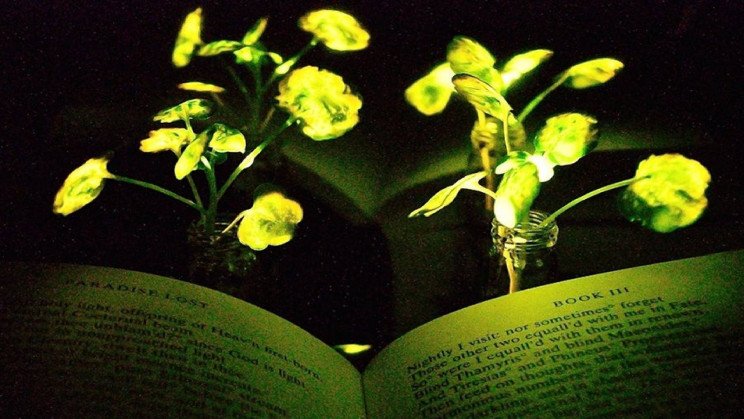MIT Wants to Replace Lights With Glowing Plants was reported by Loukia Papadopoulos for InterestingEngineering.com, 10 October 2021. The light-emitting plants can be recharged in as little as ten seconds.
HEY, could we fill our homes and offices with glowing plants that charge our devices?
 In December of 2017, researchers at MIT announced they had found a way to create light-emitting plants. They achieved this by embedding specialized nanoparticles into the leaves of watercress plants that allowed them to give off a very dim light for nearly four hours. At the time, they hoped that with further optimization, these plants could one day be bright enough to illuminate a home or office workspace. That day has come.
In December of 2017, researchers at MIT announced they had found a way to create light-emitting plants. They achieved this by embedding specialized nanoparticles into the leaves of watercress plants that allowed them to give off a very dim light for nearly four hours. At the time, they hoped that with further optimization, these plants could one day be bright enough to illuminate a home or office workspace. That day has come.
MIT engineers have now upgraded their light-emitting plants to be able to be charged by a LED in just 10 seconds, glow 10 times brighter than their first generation of plants, and last for several minutes — they can even be recharged repeatedly. “We wanted to create a light-emitting plant with particles that will absorb light, store some of it, and emit it gradually,” said Michael Strano, the Carbon P. Dubbs Professor of Chemical Engineering at MIT and the senior author of the new study in a statement. “This is a big step toward plant-based lighting.”
The specialized nanoparticles can also boost the light production of any other type of light-emitting plant. They also contain the aptly-named enzyme luciferase, a substance found in fireflies. This process is an example of the emerging field of “plant nanobionics,” wherein researchers develop ways to augment plants with novel features.
Read more: MIT Wants to Replace Lights With Glowing Plants
The case for making hearing aids and insulin monitors as sexy as an Apple product was posted by Oscar Daws for FastCompany.com, 25 October 2021. Just because something technically does its job doesn’t mean that people will be happy to use it.
 Most of us are assisted by technology all the time, whether it’s the phone we use to communicate, the spectacles we wear to see, or the smartwatches we sport to monitor our fitness. We rely on these devices and can’t imagine life without them.
Most of us are assisted by technology all the time, whether it’s the phone we use to communicate, the spectacles we wear to see, or the smartwatches we sport to monitor our fitness. We rely on these devices and can’t imagine life without them.
And yet the human response to medical devices is hugely varied, with adoption and adherence a problem around the world. It’s not because these products don’t work. They do—medical devices must be rigorously tested and proven to be clinically effective. But the human context isn’t always fully considered. How people interact with medical devices can be overlooked in favor of efficacy and regulatory needs.
There are major psychological and physical challenges that designers must overcome to convince people to engage with medical technology. It might be that the device is complicated to use. Or that it’s cumbersome. Or that we fear using it incorrectly. Or that it embarrasses us.
This is the sweet spot where designers can step in and make a difference. Done right, effective product design can tap into the psychology of behavior and communicate a product’s benefits to the end-user in a creative and empathetic fashion.
What we’re aiming to do is fill in the gap that exists between medical technology and the person for whom it’s intended. As product designers, we’re constantly seeking to understand and overcome sticking points. How are devices used? (“Intended” and “actual” don’t always tally.) Do they impede everyday activities? Do people trust them? Will people stick with them? Do they look cool?
Read more: The case for making hearing aids and insulin monitors as sexy as an Apple product


hey, my pump is sexy, I made it look like a box of crayons. Crayons make the best pumps. Let’s face it crayons allows me to color my diabetes world any way I want.
Love this! May I see a photo?